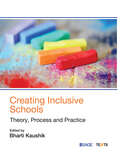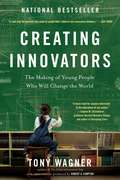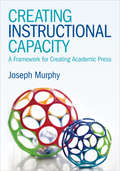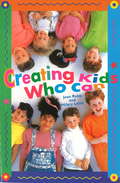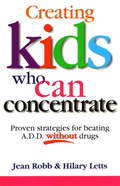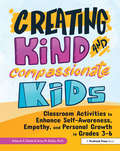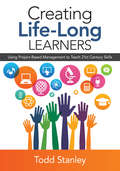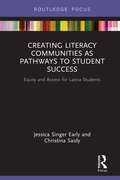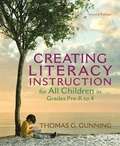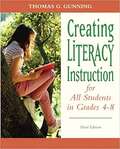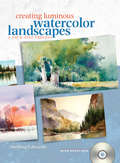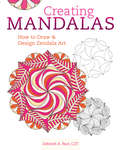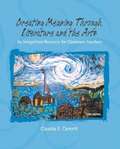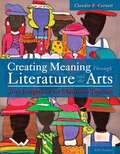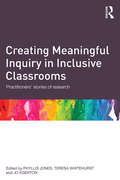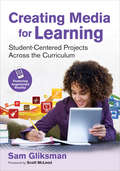- Table View
- List View
Creating Inclusive Schools: Theory, Process and Practice
by Bharti KaushikCreating Inclusive Schools aims to simplify the dynamic and multidimensional discipline of Inclusive education for the students of education, and trainee and practising teachers. This book focuses on understanding the learning needs of children with disabilities and those from the socially and economically disadvantaged sections of society. It elucidates and critically analyses how these requirements are currently addressed at various levels of education and the desirable changes that can be brought about. The book explains multifarious concepts in lucid language, and establishes crucial links between theory and practice to facilitate understanding of the different dimensions of inclusive education. This textbook offers a fresh perspective into inclusive education needs, policies and practices through contextually relevant examples and cases. It is based on the curriculum guidelines prescribed by National Council for Teacher Education (NCTE) and the syllabi recommendations by major universities across India. Key Features: Provides holistic understanding of inclusion in education with focus on various aspects of school environment and administration. Contains succinct discussion of the learning needs and strategies to address them in an inclusive education setting. Each chapter aided by learning objectives and chapter-end exercise to help readers map their progress and achievements.
Creating Inclusive Writing Environments in the K-12 Classroom: Reluctance, Resistance, and Strategies that Make a Difference
by Angela StockmanTimely and accessible, this book offers tangible strategies that will help teachers plan and sustain writing workshop experiences that are responsive to the needs of their specific students. Angela Stockman helps teachers understand why some writers may fail to meet their expectations and how to help all writers reach their fullest potential. Organized in three parts, this book reframes common narratives about resistant writers, empowers teachers to design, lead and refine their workshop, and provides a toolkit to do so. The appendices and eResources included provide teachers with instructions for mini-lessons and learning targets that support multimodal composition, perfect for pre-service and in-service teachers.
Creating Innovators
by Tony Wagner<P>From a prominent educator, author, and founder of Harvard's Change Leadership Group comes a provocative look at why innovation is today's most essential real-world skill and what young people need from parents, teachers, and employers to become the innovators of America's future. <P>In this groundbreaking book, education expert Tony Wagner provides a powerful rationale for developing an innovation-driven economy. He explores what parents, teachers, and employers must do to develop the capacities of young people to become innovators. In profiling compelling young American innovators such as Kirk Phelps, product manager for Apple's first iPhone, and Jodie Wu, who founded a company that builds bicycle-powered maize shellers in Tanzania, Wagner reveals how the adults in their lives nurtured their creativity and sparked their imaginations, while teaching them to learn from failures and persevere. <P>Wagner identifies a pattern--a childhood of creative play leads to deep-seated interests, which in adolescence and adulthood blossom into a deeper purpose for career and life goals. Play, passion, and purpose: These are the forces that drive young innovators. <P>Wagner shows how we can apply this knowledge as educators and what parents can do to compensate for poor schooling. He takes readers into the most forward-thinking schools, colleges, and workplaces in the country, where teachers and employers are developing cultures of innovation based on collaboration, interdisciplinary problem-solving, and intrinsic motivation. The result is a timely, provocative, and inspiring manifesto that will change how we look at our schools and workplaces, and provide us with a road map for creating the change makers of tomorrow.
Creating Innovators
by Tony WagnerFrom a prominent educator, author, and founder of Harvard's Change Leadership Group comes a provocative look at why innovation is today's most essential real-world skill and what young people need from parents, teachers, and employers to become the innovators of America's future.In this groundbreaking book, education expert Tony Wagner provides a powerful rationale for developing an innovation-driven economy. He explores what parents, teachers, and employers must do to develop the capacities of young people to become innovators. In profiling compelling young American innovators such as Kirk Phelps, product manager for Apple's first iPhone, and Jodie Wu, who founded a company that builds bicycle-powered maize shellers in Tanzania, Wagner reveals how the adults in their lives nurtured their creativity and sparked their imaginations, while teaching them to learn from failures and persevere. Wagner identifies a pattern--a childhood of creative play leads to deep-seated interests, which in adolescence and adulthood blossom into a deeper purpose for career and life goals. Play, passion, and purpose: These are the forces that drive young innovators. Wagner shows how we can apply this knowledge as educators and what parents can do to compensate for poor schooling. He takes readers into the most forward-thinking schools, colleges, and workplaces in the country, where teachers and employers are developing cultures of innovation based on collaboration, interdisciplinary problem-solving, and intrinsic motivation. The result is a timely, provocative, and inspiring manifesto that will change how we look at our schools and workplaces, and provide us with a road map for creating the change makers of tomorrow. Creating Innovators will feature its own innovative elements: more than sixty original videos that expand on key ideas in the book through interviews with young innovators, teachers, writers, CEOs, and entrepreneurs, including Thomas Friedman, Dean Kamen, and Annmarie Neal. Produced by filmmaker Robert A. Compton, the videos are accessible via links and QR codes placed throughout the eBook text or by visiting www.creatinginnovators.com.
Creating Instructional Capacity: A Framework for Creating Academic Press
by Joseph F. MurphyGreat leaders create stronger foundations by building Instructional Capacity Technology and the age of information have forced educators to rethink how they can create a supportive culture and build academic press. School leaders who learn how to balance these ideas will build successful teams to meet today’s standards. In this companion to Creating Productive Cultures in Schools, Joe Murphy unpacks essential elements of building instructional capacity-Academic Press- through effective management of instruction, curriculum, and assessment. Leaders and change facilitators who read this will: Be reminded how effective instruction works and what forces shape it Understand how powerful assessment ideas can guide successful change Discover secrets to hiring and developing capacity-rich talent Know how to approach and manage curriculum for 21st century outcomes "Over the past decade increasing emphasis has been given by scholars, policymakers and practitioners to the role leaders play in building the capacity of schools to improve teaching and learning. This volume provides a sound foundation for thinking about the meaning of ′capacity′ as well as the tools leaders can use for productive impact." Dr. Philip Hallinger Professor of Educational Management, Chulalongkorn University (Thailand) "This book is a practical synthesis of what we know about fostering instructional improvement that should be a required read for every principal. Murphy goes to the heart of leadership by focusing on what can be done in any school or community to strengthen teachers’ capacity to serve all students. There are no simple checklists, but a wise distillation of core ideas that will work in complex settings." Karen Seashore Louis, Regents Professor University of Minnesota
Creating Instructional Capacity: A Framework for Creating Academic Press
by Joseph F. MurphyGreat leaders create stronger foundations by building Instructional Capacity Technology and the age of information have forced educators to rethink how they can create a supportive culture and build academic press. School leaders who learn how to balance these ideas will build successful teams to meet today’s standards. In this companion to Creating Productive Cultures in Schools, Joe Murphy unpacks essential elements of building instructional capacity-Academic Press- through effective management of instruction, curriculum, and assessment. Leaders and change facilitators who read this will: Be reminded how effective instruction works and what forces shape it Understand how powerful assessment ideas can guide successful change Discover secrets to hiring and developing capacity-rich talent Know how to approach and manage curriculum for 21st century outcomes "Over the past decade increasing emphasis has been given by scholars, policymakers and practitioners to the role leaders play in building the capacity of schools to improve teaching and learning. This volume provides a sound foundation for thinking about the meaning of ′capacity′ as well as the tools leaders can use for productive impact." Dr. Philip Hallinger Professor of Educational Management, Chulalongkorn University (Thailand) "This book is a practical synthesis of what we know about fostering instructional improvement that should be a required read for every principal. Murphy goes to the heart of leadership by focusing on what can be done in any school or community to strengthen teachers’ capacity to serve all students. There are no simple checklists, but a wise distillation of core ideas that will work in complex settings." Karen Seashore Louis, Regents Professor University of Minnesota
Creating Interdisciplinary Campus Cultures
by Schneider Klein Julie Thompson Carol GearyWith the increased support from funding agencies and in literature, an interdisciplinary culture is of growing significance. Creating Interdisciplinary Campus Cultures provides an introduction to interdisciplinary change through pragmatic strategies. Sponsored by the Association of American Colleges and Universities, this unique resource is the only book focused on creating and sustaining institutional support for interdisciplinary work. Since an interdisciplinary culture is of increasingly importance in higher education, this book gives administrators and faculty the tools they need to ensure their work is successful and sustainable.
Creating Kids Who Can
by Jean Robb Hilary LettsA practical and realistic guide for parents and teachers that focuses on a holistic and nurturing approach to learning.Creating Kids Who Can is for parents and teachers of children from preschoolers to teenagers. Jean Robb has devised a learning process that works with all children ? from those with learning difficulties to gifted children. Now Jean and her colleague Hilary Letts have written a book that focuses on an approach to learning that unlocks a child?s ability and creates a child who can learn to read and write, do maths, solve problems. There?s no magic formula or special tricks. No secrets or shortcuts. Just an approach to teaching that breaks down the barriers, does away with labels and unlocks potential.JEAN ROBB and HILARY LETTS are teachers and therapists as well as the founders of Successful Learning, a British education centre dedicated to helping children to fulfil their potential. They are also the authors of CREATING KIDS WHO CAN CONCENTRATE.
Creating Kids Who Can Concentrate: Proven Strategies for Beating A.D.D. Without Drugs
by Jean Robb Hilary LettsThis book is about success and transformation. It shows how, with patience and energy, parents and teachers can turn a child who is noisy, clumsy and forgetful into a child who is calm, careful and attentive.Creating Kids Who Can Concentrate is a practical and realistic book that shows how parents and professionals can naturally and effectively develop a child's potential to become responsible and thoughtful in a remarkably short time. The authors provide expert guidance on:* proven techiques and strategies for overcoming barriers to learning* developing every child's innate skills* how a child is labelled as having A.D.D.* dealing with disruptive or bizarre behaviour, tantrums and children who won't listen JEAN ROBB and HILARY LETTS are teachers and therapists as well as the founders of Successful Learning, a British education centre dedicated to helping children to fulfil their potential. Their first book is CREATING KIDS WHO CAN.
Creating Kind and Compassionate Kids: Classroom Activities to Enhance Self-Awareness, Empathy, and Personal Growth in Grades 3-6
by James Delisle Deborah S. DelisleCreating Kind and Compassionate Kids offers lessons and activities that promote problem solving and social-emotional learning, allowing students in grades 3-6 to become more aware of themselves and others who share their world. Each lesson:Addresses both cognitive and affective skills, enhancing students' appreciation of themselves and others.Encourages students to think creatively and critically.Teaches vital affective skills, such as empathy, tolerance, compassion, communication, and leadership.Includes one or more samples of student work to guide students' responses.Has been tested by teachers in multiple classrooms with students of all ability levels.With its focus on relevant, lasting learning experiences that encourage social and emotional growth, Creating Kind and Compassionate Kids is a resource that teachers will turn to again and again.Grades 3-6
Creating Leaders in the Classroom: How Teachers Can Develop a New Generation of Leaders
by Hilarie OwenThis book encourages the commitment of teachers and parents, in order to develop responsible, self reliant and knowledgeable young people with great leadership skills. Although the books main focus is on the development of the child and their leadership skills, it also has a subtle approach to the development of the teacher and parent. The book aims to: examine the principles of leadership from the teachers perspective look in to what leadership means to children and how they can be educated to be better leaders explore and strengthen existing good practice in schools, developing what teachers do in the classroom and its impact on leadership. In this book Hilarie Owen shares her extensive knowledge and experience with teachers and parents alike, enabling them to develop leadership talent and pass these skills on to children of all ages.
Creating Learning Settings: Physical, Digital, and Social Configurations for the Future of Education
by Gary NatrielloCreating Learning Settings examines the design and implementation of learning settings informed by the newest, most expansive insights into how people learn in the post-industrial age. Educators today are tasked with moving beyond the fixed, traditional practices that have long dominated formal schooling and becoming more dynamic and strategic in arranging learners, facilitators, resources, on-site and virtual environments, and learning experiences. Integrating contemporary theoretical approaches and empirical studies, this book offers a systematic approach to creating settings that leverage the physical, digital, resource, and social dimensions necessary to support learning.
Creating Life-Long Learners: Using Project-Based Management to Teach 21st Century Skills
by Todd M. StanleyWanted for the global workforce: thinkers (and those who can teach them) Where K-12 instruction once centered on content and memorization, today’s educators want, most of all, to teach their students to think critically and perceptively. What better way than with project-based learning (PBL)? Author Todd Stanley provides a teacher-friendly, step-by-step approach to implementing PBL, focusing on the 21st century "three R’s": readiness, responsibility, and relevance. Educators will be prepared to put this practical methodology to work right away, as they learn how to Use project and classroom management skills to create a positive, productive learning environment Develop curriculum around ten different project types Link projects with today’s standards Teach students how to effectively collaborate and bring out the best in each other Readers will find an abundance of ideas and clear guidance, along with new strategies for instilling the skills students need for tomorrow’s workforce. "If you are looking for a way to produce higher level thinkers, you really need to read this book. It is a recipe for successful life long learners." Tamara Daugherty, Teacher Lakeville Elementary School "Student lead project based learning fuses today’s classroom with the demands of the fast paced future. Students need to be able to interact and problem solve not just with each other, but also within the community and with technology. This book is a guide for helping educators make that jump with their instruction." Debra K. Las, Teacher Rochest Public Schools
Creating Life-Long Learners: Using Project-Based Management to Teach 21st Century Skills
by Todd M. StanleyWanted for the global workforce: thinkers (and those who can teach them) Where K-12 instruction once centered on content and memorization, today’s educators want, most of all, to teach their students to think critically and perceptively. What better way than with project-based learning (PBL)? Author Todd Stanley provides a teacher-friendly, step-by-step approach to implementing PBL, focusing on the 21st century "three R’s": readiness, responsibility, and relevance. Educators will be prepared to put this practical methodology to work right away, as they learn how to Use project and classroom management skills to create a positive, productive learning environment Develop curriculum around ten different project types Link projects with today’s standards Teach students how to effectively collaborate and bring out the best in each other Readers will find an abundance of ideas and clear guidance, along with new strategies for instilling the skills students need for tomorrow’s workforce. "If you are looking for a way to produce higher level thinkers, you really need to read this book. It is a recipe for successful life long learners." Tamara Daugherty, Teacher Lakeville Elementary School "Student lead project based learning fuses today’s classroom with the demands of the fast paced future. Students need to be able to interact and problem solve not just with each other, but also within the community and with technology. This book is a guide for helping educators make that jump with their instruction." Debra K. Las, Teacher Rochest Public Schools
Creating Literacy Communities as Pathways to Student Success: Equity and Access for Latina Students in STEM
by Jessica Singer Early Christina SaidyCreating Literacy Communities as Pathways to Student Success offers a model for using literacy as a pathway for secondary students to explore fields from which they are often systematically excluded. In particular, this volume demonstrates how access for young Latina students to STEM related fields can be bolstered through engagement with mentors in writing and reading programs. Written for pre- and in-service teachers, as well as scholars across disciplines, this book aims to re-conceptualize the ways in which writing can best serve ethnically and linguistically diverse students, especially girls.
Creating Literacy Instruction For All Children In Grades Pre-K to 4
by Thomas G. GunningIn response to today's need to tailor instruction for the lower grades (PreK-4), this comprehensive, practical guide gives aspiring and practicing professionals the methods and techniques they need to become highly effective teachers who are well equipped to help all students become proficient readers and writers. Creating Literacy Instruction for All Children in Grades Pre-K to 4 features lesson plans for virtually every major literacy skill or strategy, abundant lists of recommended children's reading, helpful student strategies, numerous reinforcement activities, and real-life illustrations of exemplary teaching, all designed to help teachers incorporate today's most effective teaching methods and techniques into their literacy teaching.
Creating Literacy Instruction For All Students In Grades 4 To 8
by Thomas G. GunningCreating Literacy Instruction for All Students in Grades 4 to 8 gives teachers the best available teaching strategies and sample step-by-step lesson plans for constructing lively, effective reading and writing instruction for all students. With his focus on teaching successfully in today’s diverse classrooms, renowned author Thomas Gunning gives teachers a head start in ensuring quality literacy instruction for all children.
Creating Luminous Watercolor Landscapes
by Sterling EdwardsHow to paint your world in watercolor...and have fun doing it! The day Sterling Edwards watched an artist paint an entire sky with three deft brushstrokes was the day he committed to trading his tiny oil brushes and photorealistic style in favor of big, bold strokes of watercolor. In the years since, he's developed not only a wonderfully fresh, luminous painting style, but also an approach that takes the intimidation out of this beautiful but often-mystifying medium. In this book, he shares both. Initial chapters lay the foundation for successful paintings, from choosing the right brushes to achieving vibrant colors, interesting textures and strong compositions. Step-by-step demonstrations illustrate techniques for painting rocks, skies, trees, foliage, buildings, water and other landscape elements. An easy-to-follow, four-step painting process makes for easier starts and stronger finishes, complete with rich darks and sparkling highlights. Eight complete painting projects cover a range of breathtaking scenes and seasons. Whether you're dipping into the medium for the first time or you're a watercolor devotee on a quest for clearer color and more personal statements, this book will help you make the most of the time you spend with brush in hand.
Creating Mandalas: How to Draw and Design Zendala Art
by Deborah PacéMASTER THE ART OF MAKING MANDALAS!The art of making mandalas and zendalas is less about drawing and more about slowing down and opening up to your inner creative flow. You do not have to be an artist. There is no need to know how to draw. All you need are some simple everyday tools and a little effort. Can you create a circle using a compass and pencil? Can you draw a line? Can you repeat patterns? Then YOU can create your own mandalas and zendalas!Get inspired with more than 40 project ideas, step-by-step demonstrations, templates and gallery pieces.Whether you prefer to plan or would rather go with the flow, practice pages throughout the book make it easy to get started.Find tips for adding Zentangle patterns, coloring, drawing on colored paper, with stencils, and creating gold-leafed, Spirograph-inspired and snowflake mandalas.Discover your style, whether it be structured, freeform, bold and dramatic, or whimsical, and learn to design, draw and color your own original works of mandala and zendala art. Simply breathe, reach for your pencil and begin.
Creating Meaning Through Literature and the Arts: An Integration Resource for Classroom Teachers (Third Edition)
by Claudia E. CornettThe most comprehensive text on arts integration in the market, this bestseller redefines literacy in light of the 21st century need for multiple literacies. It provides an overview of academically linked research in five arts areas: literary arts, visual art, drama, dance, and music, and is intended as a complete introduction to how to meaningfully use the arts as teaching tools on a daily basis in every curricular area. Organized around WHAT, WHY and HOW questions, Creating Meaning through Literature and the Arts, 5/e tells the story of how arts integration (AI) has grown so much in a few decades using the story of hundreds of arts-based schools–old and new, public, magnet, and charter, today’s. Each AI school story draws upon cutting edge research, evolving state standards, and constructivist beliefs to transform teaching and learning. The Enhanced Pearson eText features video resources.
Creating Meaning Through Literature and the Arts: Arts Integration for Classroom Teachers
by Claudia E. CornettThe most comprehensive text on arts integration in the market, this bestseller redefines literacy in light of the 21st century need for multiple literacies. It provides an overview of academically linked research in five arts areas: literary arts, visual art, drama, dance, and music, and is intended as a complete introduction to how to meaningfully use the arts as teaching tools on a daily basis in every curricular area. Organized around WHAT, WHY and HOW questions, Creating Meaning through Literature and the Arts, 5/e tells the story of how arts integration (AI) has grown so much in a few decades using the story of hundreds of arts-based schools–old and new, public, magnet, and charter, today’s. Each AI school story draws upon cutting edge research, evolving state standards, and constructivist beliefs to transform teaching and learning.
Creating Meaningful Inquiry in Inclusive Classrooms: Practitioners' stories of research
by Phyllis Jones Jo Egerton Teresa WhitehurstIn recent years, the concept of teachers as researchers in both special and mainstream school settings has become part of our everyday language. Whilst many educational practitioners will see the need for research within their setting, many may not be familiar with the technical elements they believe are required. Creating Meaningful Inquiry in Inclusive Classrooms shows how practitioners can engage in a wide range of educational research and explores its value to the practice of teaching and learning. It introduces the Accessible Research Cycle (ARC), an understandable and meaningful framework for classroom and school-based inquiry for educators. This supports practitioner inquiry and validates the role of the practitioner as both practitioner and researcher. The book offers guidance to practitioners on how to use the ARC using familiar language with accompanying illustrative examples from inquiry carried out in special educational settings. It promotes meaningful participation within the inquiry process for all students. As the learner population in all schools is changing and becoming more complex, the role of practitioners in exploring evidence-based educational solutions to meet the educational entitlement of children is essential. In supporting a research informed profession within education, this book will empower practitioners to become the agents of change, helping them to become reflective, strategic, investigative and inquiring practitioners.
Creating Media for Learning: Student-Centered Projects Across the Curriculum
by Sam GliksmanHelp Students Show Learning Through Media Creation Education hinges on effective communication. This book demonstrates how media has become a core component of modern communication and highlights the need to incorporate student-centered media projects throughout the curriculum. Self-expression with media will enhance the learning process and allow students to creatively demonstrate their knowledge. The strategies and tactics these pages offer equip educators to make their students enthusiastic experts at producing dynamic media projects. Content includes: The how, why, and when of prompting students to create their own media across subjects and grade levels. Keys to mastery of media formats from simple photography to eBooks to complex animations. Detailed descriptions of student projects that utilize different media. The benefits of media sharing, and how to do it responsibly. The innovative use of Augmented Reality, so readers can activate a video on the book’s printed pages with their mobile devices. Across all disciplines, mastery of media creation is central to the success of current and next generation students. Educators who implement this book’s ideas will be amazed by the resultant increase in student engagement and depth of learning. "What a thoughtful collection of student-created products. This book highlights a variety of multimedia projects, offers a multitude of best practices and practical implementation tips, and is sure to empower teachers to help students find their voice." Lisa Johnson, Eanes ISD Ed Tech @TechChef4u
Creating Media for Learning: Student-Centered Projects Across the Curriculum
by Sam GliksmanHelp Students Show Learning Through Media Creation Education hinges on effective communication. This book demonstrates how media has become a core component of modern communication and highlights the need to incorporate student-centered media projects throughout the curriculum. Self-expression with media will enhance the learning process and allow students to creatively demonstrate their knowledge. The strategies and tactics these pages offer equip educators to make their students enthusiastic experts at producing dynamic media projects. Content includes: The how, why, and when of prompting students to create their own media across subjects and grade levels. Keys to mastery of media formats from simple photography to eBooks to complex animations. Detailed descriptions of student projects that utilize different media. The benefits of media sharing, and how to do it responsibly. The innovative use of Augmented Reality, so readers can activate a video on the book’s printed pages with their mobile devices. Across all disciplines, mastery of media creation is central to the success of current and next generation students. Educators who implement this book’s ideas will be amazed by the resultant increase in student engagement and depth of learning. "What a thoughtful collection of student-created products. This book highlights a variety of multimedia projects, offers a multitude of best practices and practical implementation tips, and is sure to empower teachers to help students find their voice." Lisa Johnson, Eanes ISD Ed Tech @TechChef4u
Creating Minds: An Anatomy of Creativity as Seen Through the Lives of Freud, Einstein, Picasso, Stravinsky, Eliot, G
by Howard GardnerThe man who revolutionized our understanding of intelligence now gives us a pathbreaking view of creativity, along with riveting portraits of seven figures who each reinvented an area of human endeavor. Understanding their diverse achievements not only sheds light on the nature of creativity but also elucidates the “modern era”-the times that formed them and that they in turn helped to define.
